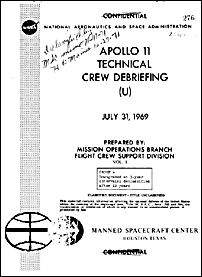

Volume 1
| 1.0 Suiting and Ingress |
| 2.0 Status Checks and Countdown |
| 3.0 Powered Flight |
| 4.0 Earth Orbit and Systems Checkout |
| 5.0 TLI through S-VIB Closeout |
| 6.0 Translunar Coast |
| 7.0 LOI through Lunar Module Activation |
| 8.0 Lunar Module Checkout through Separation |
| 9.0 DOI through Touchdown |
| 10.0 Lunar Surface |
Volume 2
| 11.0 CSM Circumlunar Operations |
| 12.0 Lift-Off, Rendezvous, Docking |
| 13.0 Lunar Module Jettison through TEI |
| 14.0 Transearth Coast |
| 15.0 Entry |
| 16.0 Landing and Recovery |
| 17.0 Geology and Experiments |
| 18.0 Command Module Systems Operations |
| 19.0 Lunar Module Systems Operations |
| 20.0 Miscellaneous Systems, Flight Equipment, and GFE |
| 21.0 Visual Sightings |
| 22.0 Premission Planning |
| 23.0 Mission Control |
| 24.0 Training |
| 25.0 Human Factors |
| 26.0 Miscellaneous |
| 27.0 Concluding Comments |
* * *
 |
Original by NASA. HTML-version created by Thomas Schwagmeier. |